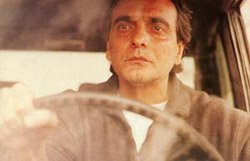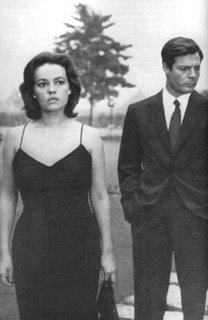The Surrealistic SpaceTime
 To start at the very beginning – last year at Marienbad (LYAM) is such a film that I cannot recall a single film to be in a close affinity with it; I am not talking about the generic superiority of the film (by generic I mean the commonplace plot, acting, music yada yada...) but am pointing out the exclusive uniqueness of the film. The cerebral experience of watching LYAM is unique; LYAM is puzzling, it is a challenging film to be comprehended, it leaves you dumbfounded, but at the same time anyone can realize that LYAM is an example of sheer experimentation where a human mind discovers the real meaning of truth in the form of art.
To start at the very beginning – last year at Marienbad (LYAM) is such a film that I cannot recall a single film to be in a close affinity with it; I am not talking about the generic superiority of the film (by generic I mean the commonplace plot, acting, music yada yada...) but am pointing out the exclusive uniqueness of the film. The cerebral experience of watching LYAM is unique; LYAM is puzzling, it is a challenging film to be comprehended, it leaves you dumbfounded, but at the same time anyone can realize that LYAM is an example of sheer experimentation where a human mind discovers the real meaning of truth in the form of art.The film begins by describing a beautiful ornate chateau. The camera rolls through the long corridors, huge walls, decorated ceilings, murals, paintings & other artifacts and a low voice slowly starts talking. The voice in the tracking shot repeats the same words and unwittingly we already start feeling eerie even though it is only a few minutes. The elegant invitees in the chateau are sitting & watching theatre. We observe a person ("X") approaches one beautiful woman ("A") and asks her -"did not we meet at Marienbad last year"? The woman keeps her silence but the man continues with his elaboration a familiar experience he had with her in a similar chateau last year, where she was finally ready to leave her husband ("M"') and run away together with him. The woman replies she did not even know Mr. X but X persists with a passionate minute detailing of what had happened in the last year. Mr. X repeats his memory repeatedly over and over again, which changes minutely between each description, all against the milieu of the hallways, rooms, and garden in the chateau.
As the film progresses the characters and the narration of the film start becoming more uncertain. Resnais masterfully handled a mixture model where present, past, and possible fantasy worlds are coagulated together. The viewers sense a confused state with the flow of the sequence of events in the chateau, wondering whether "X" & "A" had really met in Marienbad. The events we finally observe are left to our comprehension. The events might be real(that is Mr. X is meeting with A), that this chateau is really in Marienbad, that X and Y had met last year, or else it can be that X is fantasizing everything.
Resnais created a perfectly mesmerizing mood and tonal balance in the film to supplement the narration. The hypnotic tableau of figures in the garden of the chateau, the almost perfectly geometrically arranged garden in the chateau makes you wonder about mathematics (truly, the narration is such brilliantly mixed with memory/present/fantasy that you might rethink if it is a work of mathematics!) around you and everything you have seen in the film. The motif becomes clearer when we notice the elite guests are passing time by playing "Niim" (a mathematical logic game; can be played with cards). Often by using a surrealistic dream like imagery or freezing all unrequited physical objects in various shots or flashing a possible fantasy/memory shot repeatedly (with different time durations) in between a single shot Resnais confirms his grasp in connecting unclear dots in a beautiful but demanding logical progression. At the end the viewers will finally rethink “was there anything to identify with” or” did time stand still for the last one&half hour?
Decades come and go, but LYAM will remain the same with all its challenging, absorbing and at the same time – stimulating original parameters. Personally I feel there is a school of films that have a direct (and sometimes indirect) obligation towards LYAM; because LYAM teaches you how to narrate a possible linear story-type film from the subjective point of views of the protagonists, where each protagonist can nullify the others view point. I have watched LYAM a few times in recent years and each time I ended up saluting Mr. Resnais for this jewel. If you still have not seen LYAM – don't continue this crime!
Année dernière à Marienbad, L'
(Last Year at Marienbad - 1961)
Directed By : Alain Resnais



















